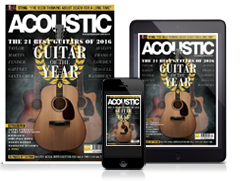Harmonic Pathways
Add a little harmony to your playing
The examples are set out in a simple order; firstly, several harmonic shapes to use in your playing, and secondly, the scale patterns I have used to find them.
The following paragraph explains some of the mechanics behind this and it is useful to know. However, if music theory will put you off playing then all you really need to grasp is: "You can play really cool lead lines by playing two notes at the same time, from the same scale" - got it? Okay, let's take a look.
Here's the more in-depth stuff… When we play a chord, we play three notes or more together that create a harmony, or the sound of several notes working together. All of the notes used in these chords can be found in the relevant scale; this means that any note in that same scale when played simultaneously with another note from that scale will create a pleasurable and harmonious sound (a harmony). Particular intervals (gaps between notes) will produce a specific atmosphere or emotion. Ultimately, this means that when playing a solo or melodic line you can "beef" up your sound by simply doubling that melody note with another note from the scale, just like a chord. The result is harmonic lead playing.
In example one, you can see a variety of two note shapes. These are shapes taken from the scales tabbed out in example two; I like to call these shapes "harmonic pathways" as they are found within the scale patterns themselves, bridging gaps and taking us on a bit of a journey. Notice how the shapes or "harmonic pathways" have a scale-like progression to them as they progress up the fretboard; because these shapes have been taken from the E minor (G major) scales in example two; if you look at the tab, you should be able to see how they bridge the gap between these scale patterns perfectly creating those "harmonic pathways". Take some time to enjoy these and then find your own. Check out the video in the digital edition to hear an example of how to use them.
The final two examples are based around D major (B minor). Firstly, we have the shapes or "harmonic pathways" and, secondly, we have the scales. So there is plenty for you to get started with. Make sure you are using your ear; evaluate what you hear, try and find the same harmonies in different places and perhaps even try to identify what interval it is you are playing. The most valuable practice time is time spent exploring and in this column you have been given the equipment to explore far and wide. Take the challenge on with confidence and discover new things for yourself; it feels really good when you get there.
Get the MusicRadar Newsletter
Want all the hottest music and gear news, reviews, deals, features and more, direct to your inbox? Sign up here.


“Beyond its beauty, the cocobolo contributes to the guitar’s overall projection and sustain”: Cort’s stunning new Gold Series acoustic is a love letter to an exotic tone wood
“Your full-scale companion. Anytime. Anywhere… the perfect companion to your full-size Martin”: Meet the Junior Series, the new small-bodied, travel-friendly acoustic range from Martin









